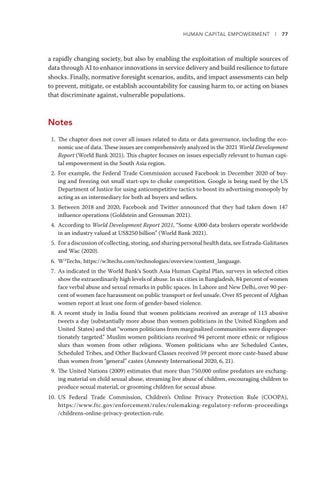Human Capital Empowerment l 77
a rapidly changing society, but also by enabling the exploitation of multiple sources of data through AI to enhance innovations in service delivery and build resilience to future shocks. Finally, normative foresight scenarios, audits, and impact assessments can help to prevent, mitigate, or establish accountability for causing harm to, or acting on biases that discriminate against, vulnerable populations.
Notes 1. The chapter does not cover all issues related to data or data governance, including the economic use of data. These issues are comprehensively analyzed in the 2021 World Development Report (World Bank 2021). This chapter focuses on issues especially relevant to human capital empowerment in the South Asia region. 2. For example, the Federal Trade Commission accused Facebook in December 2020 of buying and freezing out small start-ups to choke competition. Google is being sued by the US Department of Justice for using anticompetitive tactics to boost its advertising monopoly by acting as an intermediary for both ad buyers and sellers. 3. Between 2018 and 2020, Facebook and Twitter announced that they had taken down 147 influence operations (Goldstein and Grossman 2021). 4. According to World Development Report 2021, “Some 4,000 data brokers operate worldwide in an industry valued at US$250 billion” (World Bank 2021). 5. For a discussion of collecting, storing, and sharing personal health data, see Estrada-Galiñanes and Wac (2020). 6. W3Techs, https://w3techs.com/technologies/overview/content_language. 7. As indicated in the World Bank’s South Asia Human Capital Plan, surveys in selected cities show the extraordinarily high levels of abuse. In six cities in Bangladesh, 84 percent of women face verbal abuse and sexual remarks in public spaces. In Lahore and New Delhi, over 90 percent of women face harassment on public transport or feel unsafe. Over 85 percent of Afghan women report at least one form of gender-based violence. 8. A recent study in India found that women politicians received an average of 113 abusive tweets a day (substantially more abuse than women politicians in the United Kingdom and United States) and that “women politicians from marginalized communities were disproportionately targeted.” Muslim women politicians received 94 percent more ethnic or religious slurs than women from other religions. Women politicians who are Scheduled Castes, Scheduled Tribes, and Other Backward Classes received 59 percent more caste-based abuse than women from “general” castes (Amnesty International 2020, 6, 21). 9. The United Nations (2009) estimates that more than 750,000 online predators are exchanging material on child sexual abuse, streaming live abuse of children, encouraging children to produce sexual material, or grooming children for sexual abuse. 10. US Federal Trade Commission, Children’s Online Privacy Protection Rule (COOPA), https://www.ftc.gov/enforcement/rules/rulemaking-regulatory-reform-proceedings /childrens-online-privacy-protection-rule.

